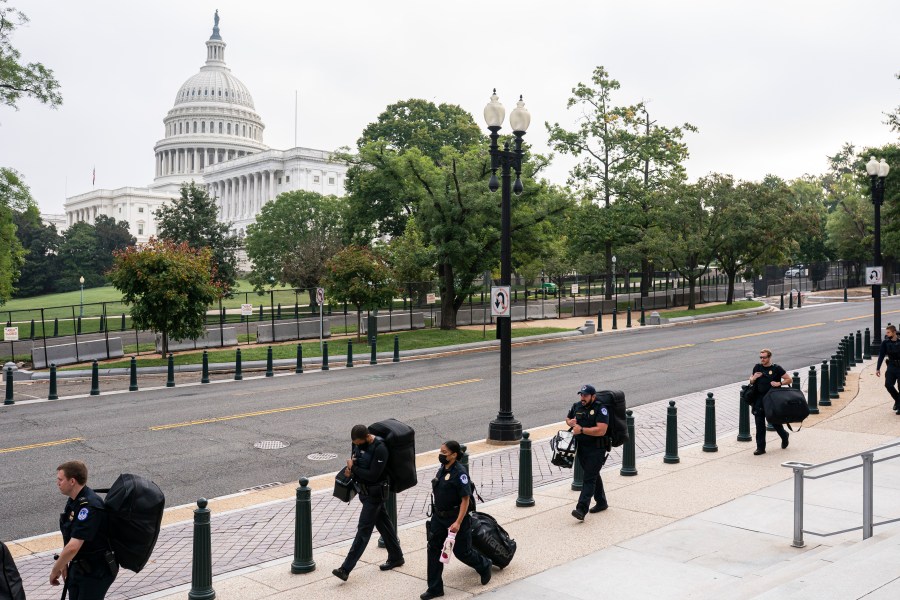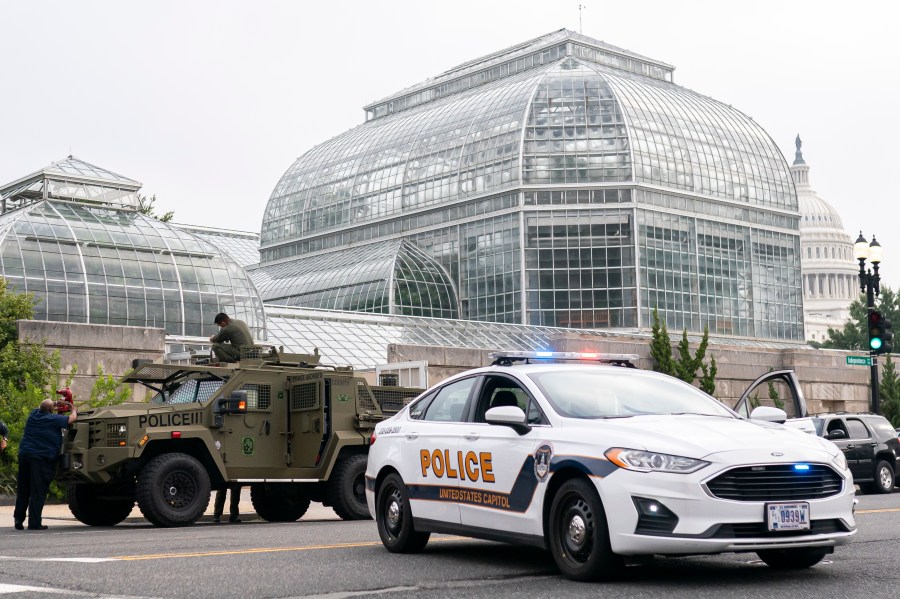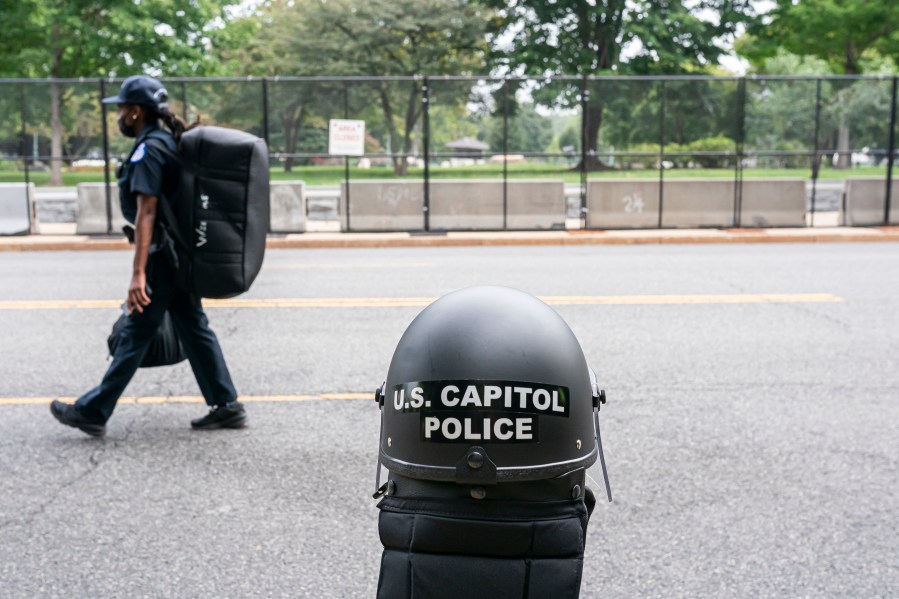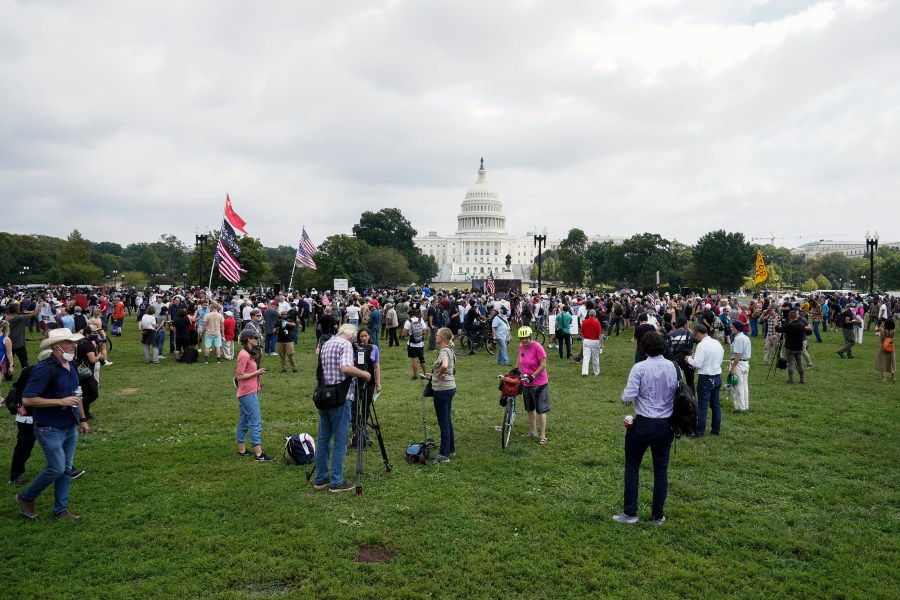WASHINGTON (AP) — In the shadow of a fortified Capitol, a few hundred demonstrators turned up Saturday for a rally to support those charged in January’s riot but were vastly outnumbered by the media and a heavy police presence.
U.S. Capitol Police were taking no chances, with hundreds of officers brought into Washington in an effort to avoid a repeat of the pre-inauguration attack. The fence around the Capitol was put back up, the city police force was fully activated, and Capitol Police requested assistance from the National Guard.
There were a few scuffles as the rally started, and one person was arrested for carrying a knife, police said, but no significant incidents were reported. Still, law enforcement officials remained on edge, concerned about the possibility of violent protesters and counterprotesters. Police were also preparing for the possibility that some demonstrators might arrive with weapons, though backpacks were allowed into the area and there were no checkpoints.
The rally was ringed by heavy dump trucks and took place in fields far from the Capitol building. Law enforcement officers geared up at staging areas and metal barricades were placed around the streets. Inside the Capitol, police riot shields were placed near doors and windows, a stark difference from January, when officers inside were left without riot equipment and quickly overwhelmed as the crowd stormed inside.

Persistent attempts to rewrite the narrative of the violence and panic of Jan. 6, and the increasing volatility behind the lie that the 2020 election was stolen, had made it impossible to predict what might happen this weekend. After all, law enforcement was only expecting a free speech protest the day Trump supporters stormed the Capitol in an effort to disrupt the certification of Joe Biden’s victory.
Capitol Police Chief Tom Manger said at a news conference Friday it was difficult to say whether threats of violence at the event were credible, but “chatter” online and elsewhere has been similar to intelligence that was missed in January.
The rally, organized by former Trump campaign staffer Matt Braynard, aimed to support people detained after the Jan. 6 insurrection — about 63 people held behind bars out of the more than 600 charged in the deadly riot. It’s just the latest attempt to downplay and deny the January violence. In an MSNBC interview, he downplayed the low numbers in attendance, saying instead the media coverage of the event helped get the message out.
Intelligence collected before the rally suggested that extremist groups such as the Proud Boys and Oath Keepers would turn up. But some prominent members of the groups had sworn they weren’t going and told others not to attend. Far-right online chatter has been generally tame, and Republican lawmakers downplayed the event.
Former U.S. Capitol police chief Kim Dine shares his perspective on the ‘Justice for J6’ rally
Defense Secretary Lloyd Austin approved a request for about 100 members of the D.C. National Guard to be stationed at a city armory near the Capitol, to be called if needed as backup. They were without firearms but were equipped with batons and protective vests for self-defense.
Congress is out of session and no lawmakers were expected to be in the building Saturday. Biden was in Delaware for the weekend.
Many commenters on online platforms such as Telegram that are popular with the far-right disavowed the rally, saying they believed law enforcement was promoting the event to entrap Trump supporters. Some urged their followers not to attend an event they said was secretly organized by the FBI.

At the same time, however, some commenters continued to promote rallies planned in cities and state capitals across the country.
Meanwhile, Donald Trump was still using his platform as the most popular leader in the GOP to express sympathy for those who were arrested and continue spreading election misinformation, ratcheting up his attacks as the week wore on.
The Associated Press reviewed hundreds of court and jail records for the Capitol riot defendants to uncover how many were detained and found roughly 63 held in federal custody awaiting trial or sentencing hearings. Federal officials are still looking for other suspects who could also wind up behind bars.
At least 30 are jailed in Washington. The rest are locked up in facilities across the country. They have said they are being treated unfairly, and one defendant said he was beaten.
Federal authorities have identified several of those detained as extremist group leaders, members or associates, including nine defendants linked to the Proud Boys and three connected to the anti-government Oath Keepers. Dozens are charged with conspiring to mount coordinated attacks on the Capitol to block Congress from certifying the 2020 Electoral College vote, among the most serious of the charges.
Some jailed defendants are charged with assaulting police officers, others with making violent threats. A few were freed after their arrests but subsequently detained again, accused of violating release conditions.
The U.S. Court of Appeals for the District of Columbia Circuit has set standards for judges to apply in deciding whether to jail a Capitol riot defendant. A three-judge panel of the appeals court ruled in March that rioters accused of assaulting officers, breaking through windows, doors and barricades, or playing leadership roles in the attack were in “a different category of dangerousness” than those who merely cheered on the violence or entered the building after it was breached.
But it’s unclear how the cases for the majority of those charged will end. On Friday, a California woman who joined the mob avoided a prison term when a federal judge sentenced her to probation, an outcome fitting an early pattern in the Jan. 6 riot prosecutions.
Associated Press writers Michael Kunzelman, Mary Clare Jalonick, Jacques Billeaud, David Klepper, Lisa Mascaro, Jake Bleiberg, Amanda Seitz, Ashraf Khalil and Robert Burns contributed to this report.












